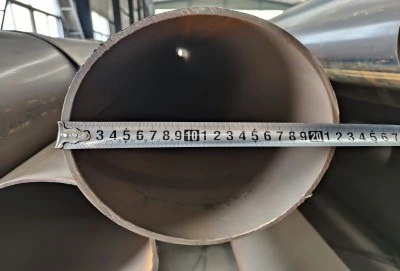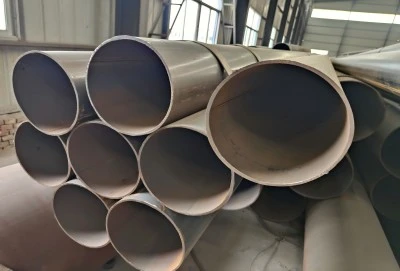Electric Resistance Welded (ERW) pipes are a crucial component in various industries, from oil and gas to construction and infrastructure. As the name suggests, these pipes are created using a specific welding process, but a common question arises: Does the electric resistance welded pipe have a seam? In this comprehensive guide, we'll explore the intricacies of ERW pipes, their manufacturing process, and the characteristics of their seams.
|
|
|
How Does The Electric Resistance Welding Process Create The Seam?
The electric resistance welding process is a highly efficient method for creating high-quality pipes with consistent seams. To understand how the seam is formed, let's break down the ERW process step by step:
- Strip Preparation: The process begins with a flat steel strip, which is carefully selected based on the desired pipe specifications.
- Forming: The steel strip is gradually curved into a cylindrical shape using a series of rollers. This forming process is crucial in preparing the edges for welding.
- Edge Alignment: As the strip is formed into a tube, the edges are brought together, creating a small gap known as the weld seam.
- Welding: High-frequency electrical current is applied to the edges of the strip. The resistance to this current generates intense heat, causing the edges to melt and fuse together.
- Pressure Application: Immediately after heating, pressure is applied to the welded area using squeeze rolls. This pressure ensures a strong, uniform bond along the entire length of the pipe.
- Cooling: The welded seam is rapidly cooled, typically using water, to solidify the weld and maintain the pipe's structural integrity.
- Post-Weld Treatment: In many cases, the pipe undergoes additional treatments such as heat treatment or mechanical working to enhance its properties and remove any residual stresses.
This process results in a continuous, longitudinal seam along the length of the pipe. The seam is typically very narrow and, when properly executed, can be nearly indistinguishable from the rest of electric resistance welded pipe wall.
Characteristics Of The Seam In ERW Pipes
The seam in electric resistance welded pipes has several unique characteristics that contribute to the overall quality and performance of the pipe:
- Consistency: One of the primary advantages of ERW pipes is the consistency of the seam. The automated welding process ensures a uniform weld along the entire length of the pipe.
- Strength: When properly executed, the ERW seam can be as strong as or even stronger than the base metal of the pipe. This is due to the precise control of heat and pressure during the welding process.
- Narrow Heat-Affected Zone: The ERW process produces a very narrow heat-affected zone (HAZ) compared to other welding methods. This minimizes the impact on the pipe's overall mechanical properties.
- Smooth Surface: The ERW seam is typically very smooth, both internally and externally. This smooth surface is beneficial for applications requiring low friction or smooth fluid flow.
- Minimal Material Loss: Unlike some other pipe manufacturing methods, the ERW process results in minimal material loss, making it an efficient and cost-effective option.
- Versatility: ERW pipes can be produced in a wide range of sizes and wall thicknesses, making them suitable for various applications across different industries.
It's important to note that while the seam is a inherent feature of ERW pipes, advancements in technology have made it possible to produce seams that are nearly invisible to the naked eye and have minimal impact on the pipe's performance.
Testing And Quality Assurance For Seams
To ensure the integrity and reliability of electric resistance welded pipes, rigorous testing and quality assurance measures are implemented throughout the manufacturing process. These tests focus particularly on the seam, as it is a critical area that determines the overall strength and performance of the pipe. Some of the key testing methods include:
- Non-Destructive Testing (NDT):
- Ultrasonic Testing: High-frequency sound waves are used to detect any internal flaws or inconsistencies in the weld seam.
- Eddy Current Testing: This method uses electromagnetic induction to identify surface and near-surface defects in the seam.
- Magnetic Particle Inspection: For ferromagnetic materials, this test can reveal surface and slightly subsurface discontinuities in the weld area.
- Hydrostatic Pressure Testing: The pipe is subjected to internal pressure to verify its strength and detect any leaks, particularly along the seam.
- Mechanical Testing:
- Tensile Testing: Samples are taken from the pipe, including the weld area, to measure tensile strength and ductility.
- Flattening Test: Sections of the pipe are flattened to assess the ductility and integrity of the weld seam under extreme deformation.
- Bend Test: The pipe is bent to a specified angle to evaluate the flexibility and strength of the seam.
- Metallographic Examination: Cross-sections of the weld seam are examined under a microscope to assess the microstructure and identify any irregularities or defects.
- Corrosion Testing: For pipes intended for corrosive environments, specific tests are conducted to ensure the seam's resistance to various corrosive agents.
- Visual Inspection: Trained inspectors perform visual examinations of the pipe surface, paying particular attention to the seam area for any visible defects or inconsistencies.
These comprehensive testing procedures ensure that ERW pipes meet or exceed industry standards and specifications. Quality assurance measures are implemented at every stage of production, from raw material selection to final inspection, guaranteeing the reliability and performance of the finished product.
Longma Group
Electric resistance welded pipes play a crucial role in various industries, offering a balance of strength, efficiency, and versatility. While these pipes do indeed have a seam, advanced manufacturing techniques and rigorous quality control measures ensure that this seam is a strength rather than a weakness. The ERW process creates pipes with consistent, high-quality seams that meet the demanding requirements of modern applications.
Longma Group Electric Resistance Welded Steel Pipe is manufactured to meet a range of industry standards, ensuring quality and reliability. Adhering to specifications from API 5L, ASTM A53, ASTM A500, ASTM A252, and ASTM A795, these pipes are designed for various applications in the oil, gas, and construction industries, providing a robust solution for both structural and pressure piping needs. If you are choosing your electric resistance welded pipe manufacturers, welcome to contact LONGMA GROUP at info@longma-group.com.














